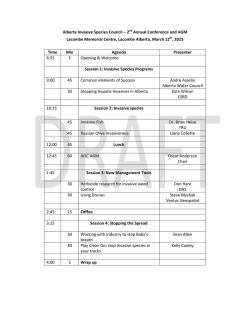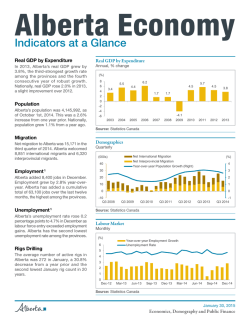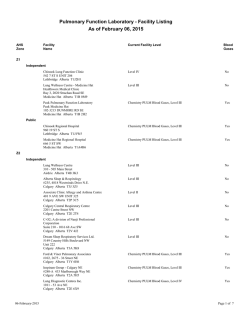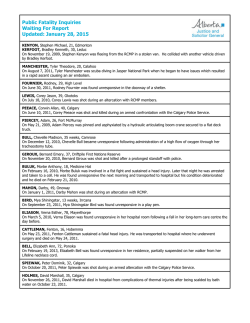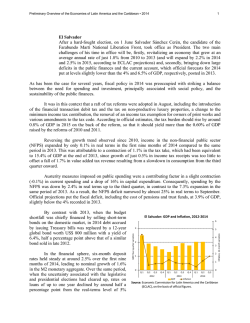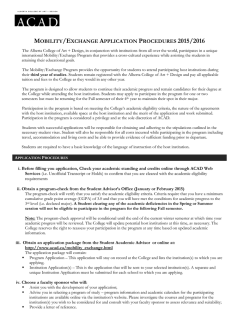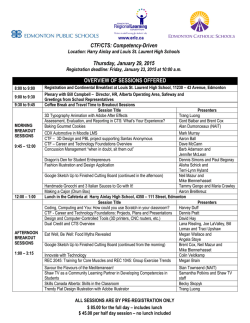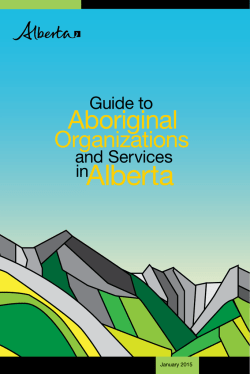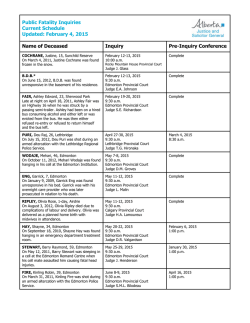
Economic Trends - Alberta Treasury Board and Finance
Economic Trends Indicators soften heading into 2015 December’s positive employment reading created some momentum in Alberta’s labour market heading into 2015. There are signs, however, that sharply lower oil prices are starting to weigh on activity. December housing starts were down, and the resale housing market underwent a correction, as sales and listings moved in opposite directions. Rig activity dropped in January, while manufacturing and export growth has slowed. This month’s InFocus discusses how the Alberta economy fared in 2014. Household Sector Solid employment growth Alberta’s labour market finished the year strong, adding 8,400 jobs in December and increasing 2.8% year‑over‑year (y/y). Overall, employment growth accelerated in the fourth quarter, offsetting softness in the third quarter. Despite adding jobs, the unemployment rate increased by 0.3 percentage points to 4.7% in December as more people entered the labour force. January 2015 ‐ Economic Trends Earnings growth in 2014 has also been solid, up 4.0% over 11 months of the year, although gains have tapered off since August. Housing market begins to slacken Indicator Latest Month Value Change year‑over‑year (y/y) Employment (thousands) December 2,072 +2.9% Unemployment Rate December 4.7% -0.0 p.p. CPI Inflation (unadjusted) December 1.9% -0.2 p.p. Retail Sales November $6.6 B +5.8% Housing Starts (annualized) December 35,200 -2.2% January 273 -30.8% Manufacturing Shipments November $6.5 B +1.5% Exports (unadjusted) November $9.1 B +4.1% Rigs Drilling (unadjusted) Source: Statistics Canada, CAODC, CMHC. p.p.= percentage points. Housing market loosens The Alberta housing market eased off at the end of 2014 after showing impressive strength for most of the year. Peak activity happened in the summer, with housing starts drifting lower over the last three months, falling to 35,200 (annualized) in December. The resale market was consistently tight throughout the year, with sales outpacing listings by a fair margin. This changed in December when the sales‑to‑new listings ratio fell to 0.50, as the two largest cities of Sales‐to‐new listings ratio for Alberta, Calgary & Edmonton Chart 1: Housing market falls back into balance Sales-to-new listings ratio for Alberta, Calgary and Edmonton (ratio) 1.0 0.9 0.8 0.7 0.6 0.5 0.4 0.3 0.2 0.1 0.0 Seller's market Balanced market Buyer's market Alberta Calgary Edmonton Edmonton and Calgary saw a decrease in sales and a large increase in listings (Chart 1). The average resale price of a home in Alberta came down slightly from November, but was up 2.7% y/y in December. Inflation eases PDF name: chrt_01.pdf The recent fall in oil prices caused inflation to fall to 1.9% in December below 2% for the first time since June. This decrease was primarily the result of lower gasoline prices, which were down 16.3% y/y in December. Shelter increased 3.5% y/y. Since August, food has been increasingly adding to inflation, with food prices up 4.0% y/y in December. Meat, fruit and vegetable prices were responsible. Business Sector Oil prices fall below $50 US/bbl Global oil prices have fallen by more than half to the lowest levels in almost six years. Prices had been falling since June, but accelerated downward beginning in late November when OPEC chose not to cut production. Lower prices have started to impact oil and gas activity in Alberta. The number of rigs drilling in January was 30% lower than the previous January. Source: Canadian Real Estate Association Source: Canadian Real Estate Association January 30, 2015 Economics, Demography and Public Finance Economic Trends - Indicators soften heading into 2015 Page 2/4 Prices hurt the value of business output Alberta manufacturing shipments fell by 3.8% in November to $6.5 billion. Sales were pulled down by petroleum and coal products, which have lost some value as petroleum product prices have moved down with oil prices. Despite the drop in petroleum and coal product sales. Overall manufacturing sales were up 1.5% from November 2013, owing to food products, which were up 14% on elevated prices for beef and pork. Through the first eleven months of 2014, manufacturing sales remained up a strong 8.0%. Exports also slowed late in the year. Energy exports dropped sharply in November, both because of lower prices and some temporary production issues. Export growth remained up an exceptional 18.1% year‑to‑date. Nonresidential building finishes strong Real investment in nonresidential construction rose 5.3% in the fourth quarter to finish the year up an impressive 5.0%. The value of permits built some momentum earlier in January 2015 ‐ Economic Trends the year, suggesting construction activity would remain strong; however, permits have fallen off in recent months, with November’s reading dropping by 20% from October (Chart 2). Large monthly fluctuations in building permits are common and some of Building permits show signs of waning Alberta non‐residential building permits Chart 2: Building permits dip after a summer spike Alberta non-residential building permits ($billion) 1.2 Building Permits 6-Moving Average 1.0 0.8 0.6 0.4 0.2 0.0 January 2015 ‐ Economic Trends Nov-10 May-11 Nov-11 May-12 Nov-12 May-13 Nov-13 May-14 Nov-14 Sources: Statistics Canada Chart 4: The US is swimming upstream Chart 3: Exchange rate falls further on Bank of Canada interest rate cut Source: Statistics Canada Canada-US Exchange rate. Line marks timing of interest rate cut (US cents/C$) 92 chrt_02.pdf 90 88 86 84 82 the decline may be a return to normal from elevated levels during the summer. The six‑month moving average of building permit values remains elevated compared with earlier in the year. Outside Alberta Bank of Canada shocks markets The Bank of Canada has lowered its target interest rate by 0.25 percentage points to 0.75%. The Canadian dollar had been falling for several months and immediately lost 1.5 cents (Chart 3). It PDF name: chrt_02.pdf has since declined further. The lower interest rate is meant to help mitigate some of the adverse effects of lower oil prices on the Canadian economy. The dramatic decline in oil prices will likely lower household income and wealth, suppress business investment, reduce trade revenues and weaken inflation. The lower Canadian dollar will benefit Canada’s export sector and further the Bank’s goal of maintaining a 2% inflation rate. IMF lowers forecast The International Monetary Fund recently expressed concern over numerous economies, including Russia, Japan, China and the Euro area and lowered its forecast for global economic growth in 2015 to 3.5%. The US was one of few countries for which the outlook PDF name: chrt_03.pdf has improved. The US recovery is well entrenched, as labour markets have improved significantly and activity has picked up. The improved outlook, has caused the US dollar to appreciate against most major currencies. 2015 Euro Area monetary policy In an effort to restore growth and prevent deflation, the European Central Bank will purchase €60 billion in bonds every month until September 2016. Growth in the Euro Area has been anemic, as inflation has fallen steadily for three years. The program is similar in size and design to the one implemented by the US Federal Reserve in September 2012. That program ended last year. 80 78 Aug-14 Sep-14 Oct-14 Nov-14 Source: Wall Street Journal Source: International Monetary Fund (IMF) Dec-14 Jan-15 Contact Kailer Mullet780.427.7391 January 30, 2015 Economics, Demography and Public Finance inFocus 2014 Year in Review The Alberta economy entered 2014 with terrific momentum. Real GDP growth over the previous four years had averaged an incredible 4.6%. This strength persisted in 2014, with many indicators gaining strength. Alberta’s population continued to swell, as migrants moved to Alberta in search of opportunity. Towards the end of the year, however, the economy lost some momentum, as the impact of sharply lower oil prices started to dampen activity. Business Sector Activity strengthens Business activity in Alberta expanded robustly again in 2014. International goods exports through November were up an impressive 18.1% (Chart 1), mainly on energy products, but also due to broad-based gains across several products. Oil production through the first 10 months of 2014 averaged 3.1 million barrels per day, up 10.7% over the same period in 2013. Growth came mostly from bitumen, which increased 22.6%. An exceptionally cold winter on the East Coast caused natural gas prices to spike early in the year. This set off a flurry of activity in the natural gas sector, with the number of metres drilled for gas nearly doubling in 2014, and annual production set to expand for the first time in five years. Natural gas activity was also supported by higher prices for natural gas liquids. Exports of farm products were up as last year’s bumper crop made its way to market, though the gain was limited by lower grain prices. Prices and differential decline Over 2012 and 2013, Alberta heavy oil prices were on average US$25/bbl less than similar quality crudes in the Gulf Coast (ex. Maya). In 2014, this discount was cut in half, as expanded rail capacity and additional pipelines improved market access. The number of train cars carrying crude oil was up about a third in 2014. Unfortunately for oil producers, a narrower differential has been offset by the collapse in oil prices. Higher-than-expected production in war-torn Iraq and Libya added to a surge in supply from North America, where production has increased 50% in just five years. This, combined with less demand because of weak global growth, pushed oil prices down almost 45% between June and December. Lower prices began to impact the Alberta economy at the end of 2014, with a slowdown in manufacturing sales and export values (Chart 2). Busy builders January 2015 ‐ Economic Trends PDF na Real investment in non-residential buildings increased 5.0% in 2014, the highest inFocus increase since 2008. Growth was driven by commercial investment, which grew Exports have been way up in 2014 Chart 1: Exports were way up in 2014 Alberta exports by year Alberta international merchandise exports by year ($billion) 11 2011 2012 2013 2014 10 9 8 7 January 2015 ‐ Economic Trends 6 inFocus Jan Feb Mar Apr May Jun Jul Aug Sep Oct Nov Dec Source: Statistics Canada Employment increases slows in the second half of 2014 Chart 2: After a strong start, growth started to wane in November Month‐over‐month employment level change with first & second half average Year-over-year change in Alberta manufacturing sales and international goods exports Source: Exports (%) All Exports 40 chrt_Infocus_01.pdf Energy Exports Manufacturing Shipments 35 30 25 20 15 10 5 0 Source: Statistics Canada Source: Statistics Canada January 30, 2015 Economics, Demography and Public Finance PDF na inFocus - 2014 Year in Review Page 4/4 by 6.8%. Edmonton saw the largest gains, where construction activity increased 8.3%, compared with a 4.4% increase in Calgary. The increase in activity did not result in substantially higher construction costs, which increased less than the rate of inflation. growth in the housing sector, the year ended on a sour note, with both sales of existing homes and housing starts falling substantially in December. Household Sector Outside Alberta Strong labour market pulls in migrants Though the rate of in-migration has moderated, Alberta’s labour market continued to be a strong draw for both international and interprovincial migrants in 2014. The province added 48,400 jobs for the year, almost half of the total for Canada. The unemployment rate was 4.7%, 2.2 percentage points lower than the national level. Earnings growth, up a strong 4.0% through the first eleven months of 2014, outpaced the rest of Canada. Alberta employees earn over 25% more per week than the average worker in Canada. This extra income helped to fuel consumer spending and supported growth in retail sales of over 7.0% in 2014. Albertans hit the road more; sales from gasoline stations were up 20% and new motor vehicle sales up 5.0%, with one month of data still to be released. US economy breaks out 2014 did not begin well for the US economy. A brutal winter disrupted the flow of goods and kept shoppers at home, causing real GDP to decline at an annual rate of 2.1% in the first quarter. Come spring, the US economy roared back to life, growing 4.6% in the second quarter and 5.0% in the third, the largest quarterly growth rate in more than ten years. Over the course of 2014, 2.9 million jobs were added, the most in 15 years, as the unemployment rate dropped 1.1 percentage points to 5.4%. The cost of living indoors Consumer prices in Alberta increased by 2.6% in 2014. Inflation was driven by shelter costs, which increased by 3.9%. Excluding shelter, inflation was near the historical average of 2%. There were a number of factors in 2014 that added to shelter costs. The cost of owning a home increased 3.8%, both because of higher house prices and a 15% increase in the cost of home and mortgage insurance. Though Alberta natural gas producers may have benefited from higher prices, households saw their heating bill increase by almost 20% in 2014. Food was also more expensive, with fruit, vegetable and especially meat prices increasing notably. Continued strength in housing Strong demand for housing in 2014 helped to boost residential investment and house prices. Construction began on 40,600 new Alberta homes, an increase of 12.7% from 2013, though still well below peak activity in 2006. Calgary was the center of much of the activity, with housing starts increasing by a third, compared January 2015 ‐ Economic Trends with a 5% decline in Edmonton. Residential investment in Calgary was spurred by higher prices. The Teranet-National Bank house price index increasing 8.8% in 2014, inFocus the highest among major Canadian cities and the largest increase in Calgary since 2007. Inventories of unsold homes remain low, especially in Calgary. Despite the The cost of owning and operating a home is increasing Chart 3: There are many factors pushing up shelter costs in Alberta Contribution to year‐over‐year change in shelter costs Contribution to year-over-year growth in the shelter component of the CPI (Percentage Points) 10 Rent Home and Mortgage Insurance Shelter Homeowner Costs (ex. Insurance) Utilities 5 0 -5 Jan-13 Apr-13 Jul-13 Source: Statistics Canada Source: Statistics Canada Oct-13 Jan-14 Apr-14 Jul-14 Oct-14 Much of the rest of the world did not fare so well in 2014. The Euro Area economy showed little improvement, with weak growth, chronic unemployment and deflation. A 3% sales tax hike caused real GDP in Japan to contract sharply in the second and third quarters. Russia’s economy has been battered by sanctions and plummeting oil prices. It received a further blow when the Russian central bank was forced to hike interest rates to support the Ruble,which had lost half its value since June. Despite Brazil falling PDF name: chrt_Infocus_03.pdf into recession, Brazil’s central bank was forced to do the same because of high inflation. Modest growth in Canada Economic growth in Canada was neither exceptionally good nor bad, with continued growth of a little over 2% and modest improvement in the labour market. Consumers continued to support growth, with retail sales on pace for a little under 5% growth in 2014, which would be the highest since 2010. The biggest contribution came from exports, which benefited from a resurgent US economy and a lower dollar. The loonie lost ten cents against the US dollar over the course of 2014, mostly due to US dollar strength, as the Canadian dollar appreciated against most of our major trading partners’ currencies. Inflation came in just under the Bank of Canada’s target of 2%. January 30, 2015 Economics, Demography and Public Finance
© Copyright 2025
